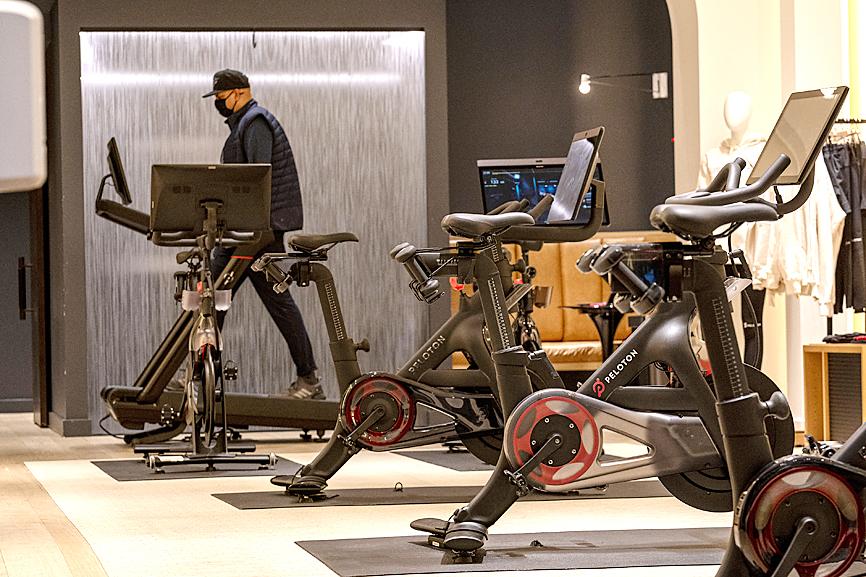Peloton Interactive Inc shares rallied up to 6.8 percent on Tuesday after announcing plans to cease in-house production and rely solely on partners for production, marking one of the exercise equipment company’s most dramatic steps yet to simplify its operations and reduce costs.
The move is an about-face from Peloton’s strategy over the past three years, when it split manufacturing between its own facilities and partners. The company built a portion of its standard Bike models and the higher-end Bike+ using facilities it acquired in 2019 as part of buying Tonic Fitness Technology Inc (期美科技). It also relied on Taiwan-based manufacturing partner Rexon Industrial Corp (力山工業) to build stationary bicycles and its Tread treadmill.
However, the firm would cease operating its Tonic facilities, and move all of its bike and treadmill production to Rexon, chief supply chain officer Andrew Rendich said.

Photo: Bloomberg
“We are going back to nothing but partnered manufacturing,” he said. “It allows us to ramp up and ramp down based on capacity and demand.”
The news sent the stock on its biggest intraday gain since Tuesday last week.
Peloton was up 3.7 percent to close at US$9.25 in New York trading on Tuesday, while Rexon rose 9.93 percent to end at NT$31.55 in Taipei trading yesterday.
Peloton is making the change after several months of turmoil. In February, cofounder John Foley was replaced as chief executive officer by veteran media executive Barry McCarthy, and the company cut nearly 3,000 employees — including many members of its executive team. Rendich was appointed to his role in March.
As gyms and economies started to reopen last year, Peloton’s growth sputtered. The company had incorrectly predicted that its business would weather the reopenings, and it was left with a glut of equipment.
As part of the new arrangement, Peloton is expanding its partnership with Rexon while also maintaining other outside partners and adding new ones.
The company plans to keep working with Quanta Computer Inc (廣達電腦) to manufacture touch screens, a key piece of its equipment.
It is also adding Pegatron Corp (和碩) to build its upcoming rowing machine.
Rendich said that new products are on track for release this year.
The company declined to say how much shutting down its operations would cost, but said that it would cut about 570 employees in Taiwan who work at the Tonic facilities.
It would retain 100 existing staffers in Taiwan to work with its outside partners, it said.
Rendich said that having dual supply chains — one internal and one external — required more resources to do well, and that simplification is necessary to drive down costs and improve product quality.
He said he has been managing two separate operations teams that would now combine into one.
“One of the best simplifications we can do is go to partner manufacturing and getting out of the business of owned manufacturing,” Rendich said. “This allows us to do it even better than we have in the past.”

China’s Huawei Technologies Co (華為) plans to start mass-producing its most advanced artificial intelligence (AI) chip in the first quarter of next year, even as it struggles to make enough chips due to US restrictions, two people familiar with the matter said. The telecoms conglomerate has sent samples of the Ascend 910C — its newest chip, meant to rival those made by US chipmaker Nvidia Corp — to some technology firms and started taking orders, the sources told Reuters. The 910C is being made by top Chinese contract chipmaker Semiconductor Manufacturing International Corp (SMIC, 中芯) on its N+2 process, but a lack

NVIDIA PLATFORM: Hon Hai’s Mexican facility is to begin production early next year and a Taiwan site is to enter production next month, Nvidia wrote on its blog Hon Hai Precision Industry Co (鴻海精密), the world’s biggest electronics manufacturer, yesterday said it is expanding production capacity of artificial intelligence (AI) servers based on Nvidia Corp’s Blackwell chips in Taiwan, the US and Mexico to cope with rising demand. Hon Hai’s new AI-enabled factories are to use Nvidia’s Omnivores platform to create 3D digital twins to plan and simulate automated production lines at a factory in Hsinchu, the company said in a statement. Nvidia’s Omnivores platform is for developing industrial AI simulation applications and helps bring facilities online faster. Hon Hai’s Mexican facility is to begin production early next year and the

AVIATION BOOM: CAL is to renew its passenger and cargo fleets starting next year on record profits as aviation continues to return to pre-pandemic levels China Airlines Ltd (CAL, 中華航空) yesterday said it is optimistic about next year’s business outlook, as the airline continues to renew its fleet on expectations that global passenger traffic would maintain steady growth and air cargo demand would remain strong. From next year to 2028, the airline is to welcome a new Boeing Co 787 fleet — 18 787-9 and six 787-10 passenger aircraft — to cover regional and medium to long-haul destinations, CAL chairman Hsieh Shih-chien (謝世謙) said at an investors’ conference in Taipei. The airline would also continue to introduce Airbus SE 321neo passenger planes and Boeing 777F cargo jets,

Who would not want a social media audience that grows without new content? During the three years she paused production of her short do-it-yourself (DIY) farmer’s lifestyle videos, Chinese vlogger Li Ziqi (李子柒), 34, has seen her YouTube subscribers increase to 20.2 million from about 14 million. While YouTube is banned in China, her fan base there — although not the size of YouTube’s MrBeast, who has 330 million subscribers — is close to 100 million across the country’s social media platforms Douyin (抖音), Sina Weibo (新浪微博) and Xiaohongshu (小紅書). When Li finally released new videos last week — ending what has